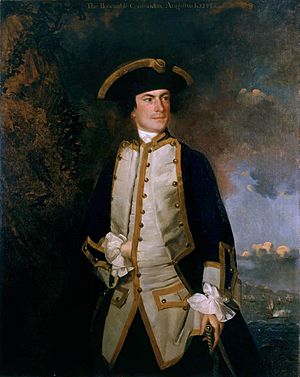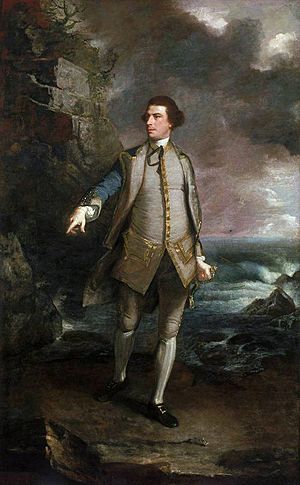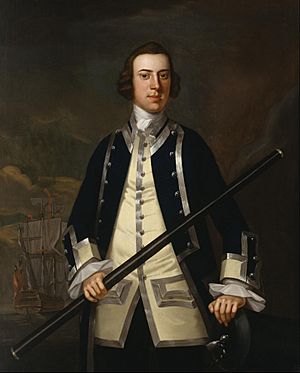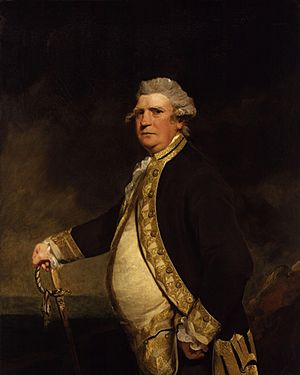Augustus Keppel, 1st Viscount Keppel facts for kids
Quick facts for kids
Viscount Keppel
|
|
|---|---|

Keppel, 1749, Joshua Reynolds's first painting of him,
produced on Menorca |
|
| Born | 25 April 1725 |
| Died | 2 October 1786 (aged 61) |
| Allegiance | Kingdom of Great Britain |
| Service/ |
Royal Navy |
| Years of service | 1735–1786 |
| Rank | Admiral |
| Commands held | HMS Wolf HMS Greyhound HMS Sapphire HMS Maidstone HMS Anson HMS Centurion Mediterranean Fleet North American Station HMS Swiftsure HMS Torbay HMS Valiant Jamaica Station Lord Commissioner of the Admiralty Channel Fleet First Lord of the Admiralty |
| Battles/wars | |
Admiral Augustus Keppel, 1st Viscount Keppel (born April 25, 1725 – died October 2, 1786) was an important officer in the Royal Navy. He was also a politician who served in the House of Commons from 1755 to 1782.
Keppel commanded several ships, including Maidstone, during the War of the Austrian Succession. Later, he became a Commodore in North America. He then led the Jamaica Station during the Seven Years' War. He also served as a top naval officer and led the Channel Fleet.
During the American Revolutionary War, Keppel had a famous disagreement with Sir Hugh Palliser. This was about Palliser's actions during the Battle of Ushant in July 1778. Both Keppel and Palliser faced formal investigations by the navy, but both were found not guilty. In the final years of the American Revolutionary War, Keppel was the First Lord of the Admiralty, a very high position in the navy.
Contents
Augustus Keppel came from a well-known Whig family. This family had arrived in England with William of Orange in 1688. Augustus was the second son of Willem van Keppel, 2nd Earl of Albemarle. His mother, Anne van Keppel, was the daughter of the 1st Duke of Richmond.
Keppel went to sea when he was only ten years old. By the age of fifteen, he had already served five years in the navy. In 1740, he joined Centurion and sailed around the world with Lord Anson. During this long journey, he almost died when the city of Paita was captured in 1741. He was promoted to acting lieutenant in March 1742. On this trip, he also became good friends with John Campbell. Keppel lost many of his teeth due to scurvy, a common disease on long sea voyages back then.
After returning in 1744, he was promoted to commander and then to post-captain. He commanded the 14-gun sloop Wolf. He then moved to other ships: Greyhound in December 1744, Saphire in February 1745, and Maidstone in November 1745. In June 1747, his ship, the Maidstone, ran aground near Belleisle while chasing a French ship. However, a naval court found him not guilty, and he was given command of another ship, Anson. He continued to serve actively until the peace treaty was signed in 1748.


In 1749, Keppel met the famous painter Sir Joshua Reynolds. When Keppel sailed to the Mediterranean in May 1749, Reynolds traveled with him to Menorca. There, Reynolds painted the first of his six portraits of Keppel. Keppel's mission was to convince the ruler of Algiers to stop the attacks by Barbary pirates. He successfully made agreements with Algiers, Tripoli, and Tunis, protecting British trade. He returned to England in July 1751.
Serving in the Seven Years' War
During the Seven Years' War, Keppel was always busy. From 1751 to 1755, he was a Commodore on the North American Station, sailing on Norwich. In 1756, he was off the coast of France. In 1758, he was sent on an expedition to capture Gorée, a French island near Africa. His ship, Torbay (74), was the first to fight in the Battle of Quiberon Bay in November 1759.
In 1757, Keppel was part of the naval court that found Admiral John Byng guilty. However, Keppel was also active among those who tried to get Byng pardoned. In March 1761, Keppel took command of HMS Valiant. He led a group of ships to capture Belle Isle, which they successfully did in June 1761.
The Havana Expedition
When Spain joined France in 1762, Keppel was sent as second-in-command with Sir George Pocock. They led the British expedition against Cuba and captured Havana. Keppel's health suffered from a fever that affected many soldiers and sailors. He received £25,000 in prize money, which was a large sum. This money helped him financially, as his family had faced money problems.
Becoming an Admiral

Keppel was promoted to rear admiral on October 21, 1762. Later that year, he became the leader of the Jamaica Station. He joined the Board of Admiralty in July 1765. He was the most senior naval officer on the board from September to December 1766. In 1768, he bought Elveden Hall in Suffolk. He was promoted to vice admiral on October 24, 1770. During the Falklands Crisis in 1770, he was supposed to lead the fleet against Spain. However, a peaceful solution was found, so he did not have to go to battle.
American War of Independence
Keppel's most important time was at the beginning of the American Revolutionary War. He strongly supported the Whig political group. This group was against King George III's government. As a member of Parliament, Keppel was a strong Whig. He believed that the King's ministers, especially Lord Sandwich, who was in charge of the navy, might try to harm him. When Keppel was promoted to full admiral on January 29, 1778, he was put in charge of the main fleet fighting France. He thought Lord Sandwich would be happy if he lost.
Before 1778, Keppel tried to convince Sandwich to put copper on the bottoms of some ships. This "coppering" helped ships sail faster and protected them from worms. Keppel later complained that Sandwich had refused his request to copper a few ships. He said that coppering "gave additional strength to the navy." The lack of copper on British ships was one reason Britain lost the Thirteen Colonies.
One of Keppel's junior admirals was Sir Hugh Palliser. Palliser was also a member of the Admiralty Board and Parliament. Keppel believed Palliser was partly responsible for the poor state of the Royal Navy. The battle Keppel fought with the French on July 27, 1778 (the First Battle of Ushant) did not go well. This was partly due to Keppel's own decisions, but also because Palliser did not follow orders. Keppel became convinced that Palliser had deliberately let him down.
The Keppel–Palliser Dispute
Even though Keppel praised Palliser in his official report, he criticized him in private. Newspapers that supported the Whig party, along with Keppel's friends, started to spread negative stories about Palliser. Newspapers supporting the government responded in the same way. Each side accused the other of disloyalty. This led to a series of public arguments in Parliament and formal naval investigations. Keppel was investigated first and found not guilty. Then Palliser was also investigated and found not guilty. Keppel left his command in March 1779. A large column was built later to celebrate Keppel's acquittal. It was ordered by Charles Watson-Wentworth, 2nd Marquess of Rockingham.
Later Political Life
When the government led by Lord North fell in 1782, Keppel became First Lord of the Admiralty. He was also given the title Viscount Keppel and joined the Privy Council. His time in office was not very successful. He disagreed with his old political friends by resigning to protest the Peace of Paris. He then joined a government formed by North and Fox, which was not popular. When this government fell in December 1783, Keppel left public life.
Keppel died on October 2, 1786, and never married. Burke, a friend who admired him greatly, said that Keppel had a noble character. He said Keppel had a strong sense of pride mixed with kindness. Since Keppel had no children, his title of Viscount ended with him.
Legacy
Several places are named after Keppel. These include Great Keppel Island and Keppel Bay in Australia. There is also Keppel Island in the Falkland Islands. Keppel's Column in Rotherham was built to remember his acquittal.
Sources
| Parliament of Great Britain (1707–1800) | ||
|---|---|---|
| Preceded by John Page Viscount Bury |
Member of Parliament for Chichester 1755–1761 |
Succeeded by John Page Lord George Henry Lennox |
| Preceded by Henry Fox John Fitzwilliam |
Member of Parliament for Windsor 1761–1780 |
Succeeded by John Hussey-Montagu Peniston Portlock Powney |
| Preceded by Sir Joseph Mawbey James Scawen |
Member of Parliament for Surrey 1780–1782 |
Succeeded by Sir Joseph Mawbey Viscount Althorp |
| Military offices | ||
| Preceded by Sir James Douglas |
Commander-in-Chief, Jamaica Station 1762–1764 |
Succeeded by William Burnaby |
| Preceded by Sir Charles Saunders |
Senior Naval Lord September 1766–December 1766 |
Succeeded by Sir Peircy Brett |
| Political offices | ||
| Preceded by The Earl of Sandwich |
First Lord of the Admiralty 1782–1783 |
Succeeded by The Viscount Howe |
| Preceded by The Viscount Howe |
First Lord of the Admiralty 1783 |
Succeeded by The Viscount Howe |
| Peerage of Great Britain | ||
| New creation | Viscount Keppel 1782–1786 |
Extinct |
See also
 In Spanish: Augustus Keppel para niños
In Spanish: Augustus Keppel para niños


